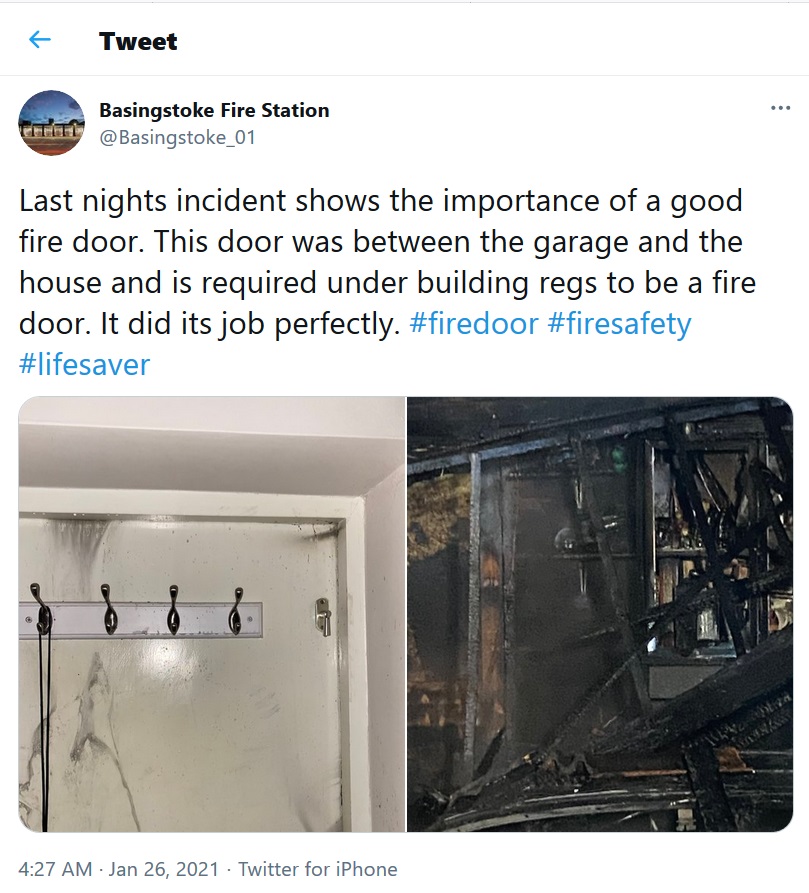When I hear about a residential fire where the door between the garage and the house prevented the fire from spreading, I like to use it as a reminder to iDigHardware readers. This morning I was surprised to realize that my last reminder was almost 5 years ago! An article in the Hampshire News arrived in my inbox yesterday, and although the residential fire occurred in England, it illustrates the value of a fire door in deterring the spread of fire from the garage to the home. The garage was a complete loss but the house suffered no damage. Here is the local fire department’s tweet:
If you have a garage attached to your home, it is very likely that the swinging door between the garage and the house is required by code to be a 20-minute fire door assembly or the equivalent. According to the International Code Council, the International Residential Code (IRC) is in use or adopted in 49 states, the District of Columbia, Guam, Puerto Rico and the U.S. Virgin Islands. The IRC requires the door between the house and the attached garage to be a minimum of 1 3/8 inches thick – either a solid wood door, a solid or honeycomb-core steel door, or a 20-minute fire door. The door must be self-closing or automatic-closing – this ensures that the door closes each time it is opened, or closes automatically if a fire occurs.
Here is the 2018 IRC section for reference:
R302.5 Dwelling-garage opening and penetration protection. Openings and penetrations through the walls or ceilings separating the dwelling from the garage shall be in accordance with Sections R302.5.1 through R302.5.3.
R302.5.1 Opening protection. Openings from a private garage directly into a room used for sleeping purposes shall not be permitted. Other openings between the garage and residence shall be equipped with solid wood doors not less than 1 3/8 inches (35 mm) in thickness, solid or honeycomb-core steel doors not less than 1 3/8 inches (35 mm) thick, or 20-minute fire-rated doors, equipped with a self-closing or automatic-closing device.
Even if your home predates the IRC requirement, a solid core or 20-minute fire door that is self-closing or automatic-closing provides important protection for your family. According to an NFPA report on home structure fires, about 3% of residential fires in the US begin in the garage – this equates to approximately 10,600 fires annually. If your garage door is standing open when a fire occurs, it has no value as a fire door. Adding spring hinges or a light-duty door closer is a minimal investment but may have a considerable impact on safety.
You need to login or register to bookmark/favorite this content.







i went a little crazy, i had an old 88 rim device and a 4030 closer and installed it on my door. the wife thinks it is pretty cool since you don’t see this on residential.
Cool! And probably pretty handy for getting through the door if you’re carrying stuff! 🙂
– Lori
My home was built in 2017 and has a 1-3/4″ thick two-panel solid core steel clad door. I looked for a label of some sorts, but there is none. In my opinion, and based on my experience, this door construction would be considered equivalent to a 20 min. rated door. It is not currently self-closing and since this construction pre-dated the 2018 IRC, it might not be required by the township. I will inquire with the local codes officer to be sure, but either way, I will add a set of spring hinges.
Hi Jerry –
Yes – I would say your door construction sounds find, and the actual label is not required by code. The IRC requirement has been around for a long time…I first wrote about it in 2009 (it’s interesting to see how the style of my posts has changed). It’s possible that your township does not use the IRC or has modified that section, but it makes good sense to make the door self-closing.
– Lori
I have a 1978 built home. The door from the kitchen to the attached garage has a glass window in it. I was told from an inspector that I don’t have a fire door and don’t need one. I thought that the code for fire doors were put in effect years ago. What is the code if this is true??
Hi Joyce –
I don’t know when the requirement was added to the International Residential Code – this code didn’t exist in 1978, and not all jurisdictions adopt it. You could change out your door for safety reasons, but it sounds like it is not required by code in your area.
– Lori